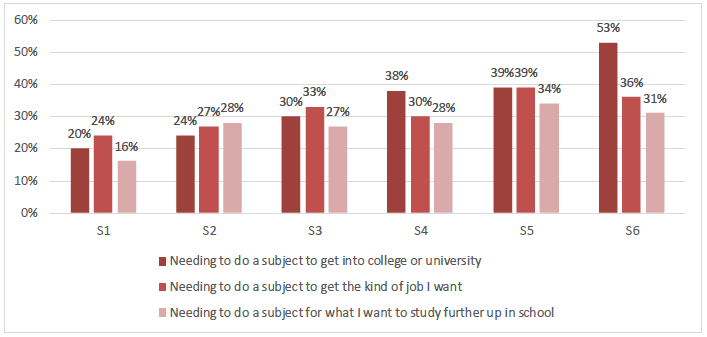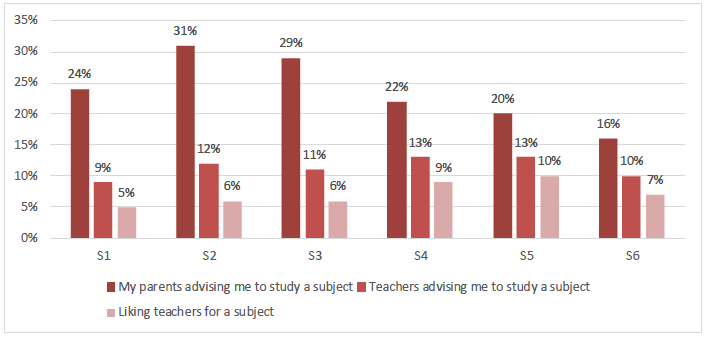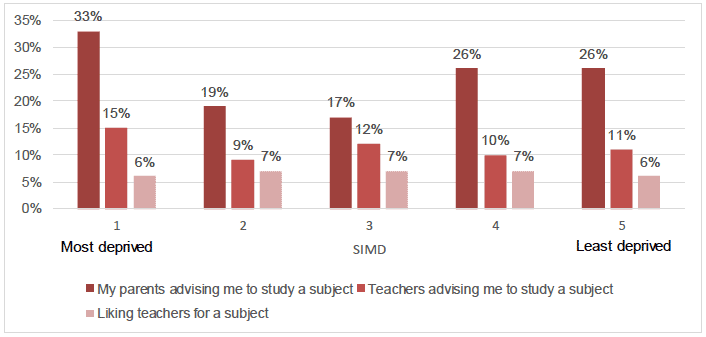Young People in Scotland Survey 2019 - course choice in senior phase: report
A report on the findings from the Young People in Scotland survey that focuses on course choice in the senior phase.
3. Reasons for Choosing Subjects/Courses
Young people were asked a range of questions on the reasons that influence their choice of subjects/courses. This chapter looks at these reasons based on stage, SIMD and gender.
3.1 What reasons do you think will be most important for you in choosing your subjects/courses for the Senior Phase? (All)
The above question is framed in the future tense, and asks respondents to think about what 'will be' the most important reason in choosing their subjects/courses. As young people in S1 and S2 have no experience of this process, their response will not reflect their lived experiences, but rather what they think will influence them, whilst those in S4-S6 will have based their answers on their own lived experience.
Young people were asked to choose the three most important factors to them in choosing their subjects/courses. They were able to choose from the following responses:
- Enjoying a subject
- Needing to do a subject to get into college or university
- Needing to do a subject to get the kind of job I want
- Needing to do a subject for what I want to study further up in school
- My parents advising me to study a subject
- Teachers advising me to study a subject
- Liking teachers for a subject
- To fit my timetable/other subject(s) did not fit my timetable
- Friends choosing this subject
- It being different from the subjects I've done before in school
- Other
- Don't know
- Prefer not to say
Out of all the options given, the most commonly reported factor was enjoying the subject, which was 39% of all respondents. Young people from the least deprived areas are more likely to choose a subject because they enjoy it (45%, compared to 31% for young people from the most deprived areas).
The most common responses have been grouped together into the following categories:
1. Future Thinking - responses based on further study in school, going to college/university and getting a job, and;
2. Outside Influences - responses based on liking the subject teacher and teacher/parental advice and guidance.
Results for all categories are provided in the Annex.

Base: 1,731[2]
Figure description:
Factors influencing course choice – Percentage of young people citing future thinking by stage. Factors are needing to do a subject to get into college or university, needing to do a subject to get the kind of job I want and needing to do a subject for what I want to study further up in school.
Responses from S1 to S6 suggest that young people think about their future more when they are older. Young people in S6 prioritise 'needing to do a subject to get into college or university' (53%) over 'needing to do a subject to get the kind of job I want' (36%). For young people in S1 these figures are much lower (20% and 24% respectively). This is most likely due to young people in the lower end of secondary school not being in a position to choose courses yet.

Base: 1,731[3]
Figure description:
Factors influencing course choice – Percentage of young people citing outside influences by stage. Factors are my parents advising me to study a subject, teachers advising me to study a subject and liking teachers for a subject.
Influence from parents in course choice declines from S2 to S6, however parents are still reported as the most common outside influence in course choice (31% to 16%).
Young people in the most deprived areas (SIMD 1) are more likely to choose subjects based on parent (33%) or teacher advice (15%) compared to young people in the least deprived areas (SIMD 5) (26% and 11% respectively).

Base: 1,731
Figure description:
Factors influencing pupil course choice – Percentage of young people citing outside influences by SIMD. Factors are my parents advising me to study a subject, teachers advising me to study a subject and liking teachers for a subject.
Young people from the most deprived areas (SIMD 1) are influenced more by their parents (33%) than young people from the least deprived areas (SIMD 5) (26%).
Females are most likely to choose subjects because they enjoy them (40% compared to 39% for males). Females are more likely to choose subjects based on future thinking (41% to get into college/university and 35% to get the job they want compared to 24% and 26% for males). Males are more likely than females to choose subjects based on outside influences (26% from parents advice and 14% from teachers advice compared to 23% and 10% for females). Both males and females are unlikely to choose subjects based on what their peers are choosing (<10%).[4]
Contact
Email: Social_Research@gov.scot
There is a problem
Thanks for your feedback